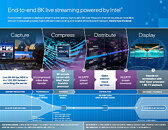Wednesday, August 11th 2021

Tokyo Olympics 8K Broadcast Was Powered by Intel Xeon Platinum 8380H Servers
Intel has recently unveiled that their technology powered the 8K 60 FPS Tokyo Olympics broadcast which was available to select customers in Japan. The games were recorded in 8K at 60 FPS with 4:2:2 Chroma subsampling and 10-bit HDR which resulted in a bitrate of 48 Gbps. This uncompressed stream was then encoded on servers each featuring quad 28 core Xeon 8380H processors and 384 GB of ram into two HEVC distribution streams at 250 Mbps and 50-100 Mbps bitrates. These streams were then distributed to users over the internet where the 8K stream could be decoded and displayed on an 8K TV over HDMI 2.1. Intel used a workstation PC with an 18-core Xeon W-2295 and 64 GB of ram to decode and play the video stream on the TV. This 8K service was only made available to select NHK subscribers in Japan while most international broadcasts offered a maximum resolution of 4K.

53 Comments on Tokyo Olympics 8K Broadcast Was Powered by Intel Xeon Platinum 8380H Servers
networkbuilders.intel.com/docs/accelerating-x265-the-hevc-encoder-with-intel-advanced-vector-extensions-512.pdf
see: Figure 2 . Improvements in fps over Intel® AVX2 (%)
You had to go fishing to find any major improvements when they added AVX2 to x265 for the same reason (because most of the code path is not vectorizable), so this is just a paid advertisement from Intel. You might get it into 20% improvement when you jump that source size up to 8k, but we are still not talking anything really improved over Zen 3's beefy AVX2 units (which you get twice as many of per socket).
Also, enjoy that frequency drop impacting everything else your beefy server is doing; frrom Intel's same paper:
I'd happily go back to a 1080p TV if was ultrawide - 2560x1080p is better than having 25% of my entire screen wasted with black bars and that lower resolution would make 120Hz easier too, useful for 24Hz content like movies as it maps perfectly without the juddery 3:2 framrate pulldown.
Sadly, nobody makes a 2560x1080p television in the ~75" range I'd be interested in - definite gap in the market there...
Can we please get 1080p right before we talk about 8K?
Here in the USA 21:9 television sets existed in the mid-2010s like this discontinued model:
www.amazon.com/VIZIO-XVT-21-Cinemawide-58-inch/dp/B008ESGRX4
but the 21:9 form factor disappeared with the failure of 3D TV broadcast.
Much more than movies, live sports broadcasts are a more important factor in determining what technology makes it into consumer electronics. The world has basically settled on the 16:9 aspect ratio for sports.
I used to say that TVs should be in 16:9 no matter what because that was the common broadcast ratio, but the thing is that broadcast TV is dying off and most of the streaming services use the original 2.35:1 aspect ratios now, making the black bars far more common, if not the norm.
And most made-for-Streaming movies just play at 16:9.
I don't really see the use case for doubling your TV's width, aside from side-by-side dual feeds (for the truly bored multitasker)
:)
In Australia (a third-world country for internet speeds), download speeds can reach 100 Mbps and upload speeds can reach 40 Mbps if you’re on the fastest fibre broadband plan. Yes, we spell fiber differently.
Have to confess I did not watch any of the this years competitions so it could of ran on a potato and I wouldn't care.
For gaming and web browsing I'd much rather have 16:9 displays. I'm just annoyed that I can't even find a single ultrawide television for sale.
The only media content that is still 16:9 is stuff like news, chat shows, sports. TV series made in the last few years are often ultrawide, all films are ultrawide, even some popular youtube streams are now ultrawide!
I don't think it's unreasonable, as a consumer, to want to buy a device that matches the aspect ratio of the content I'm paying for.
www.panamorph.com/